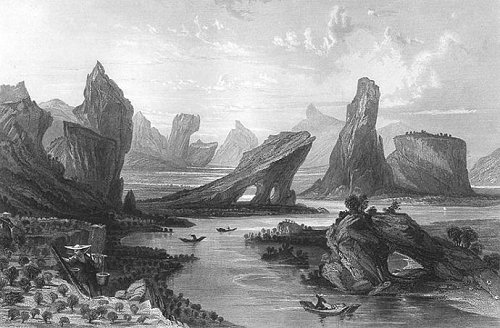




Celebrated for the culture of the most delicious description of tea, the Woo-e-shan hills are still more memorable by the legends that are entwined around their picturesque rocks, that are located in their deep and many caverns, and that are pinnacled on their cloud-capp'd summits. The hilly region of Woo-e includes thirty-six lofty and conspicuous peaks, situated to the south of the Tsung-nan, in the district of Keen-ning foo, and province of Fo-kien. Amidst these grotesquely-formed masses of limestone, the "Kew-keuh-ke," or River of the Nine Bends, makes its tortuous way, adding fertility and ornament to this singular landscape ; and every rock, and crag, and cliff, that overhangs its stream, is allegorized in the poetry or the traditions of the people.

These hills derive their name from a deity named Woo-e-keu, or Prince Woo-e, who frequently descended from his cloudy mansion, and fixed his temporary abode on whichever of the thirty-six pinnacles was most pleasing to him at the time. Who were the objects of this prince's care and affection, or from what race he was sprung, does not appear but it is said in the "See-seen-chuen," or Traditions of the Immortals, that a prince styled Tseen-kang had two sons: the name of the elder was Woo; of the younger, E. To these sons his crown descended; but one only, the elder, is spoken of as having ever visited his inheritance. His palace, however, was wholly inaccessible to mortals, standing on the highest point of a detached and lofty peak, whose sides all around were completely perpendicular. Whether the mansion of the mystic monarch still survives, is as difficult to be ascertained at the present day, as when his majesty occupied it; for, the "Ta-wang-fung'or Peak of the Great King, also called the "Tseen-choo," or Pillar of Heaven, has never yet been ascended.
The province of Fo-kien being once afflicted with a long-continued drought, so wasting in its effects that the cattle died, the crops withered, and all nature seemed to droop; looking to their monarch, who was of the Wei dynasty, the people solicited his counsel in this dread extremity. The king, condescending to come amongst his subjects, entered the valley of the River of the Nine Bends; and, on the great sloping rock that leans over the waters, as an altar suitable to the God of nature, made an offering of wine and dried fruits; he sacrificed live victims at the same time to the genu of the valley, and supplicated their aid in inducing the heavens to let fall their moisture, in the fertilizing form of dew or rain. When the ceremony was ended, an object was discerned in the sky, which, as it drew nearer, was perceived to be an elf riding on a store, and moving with rapidity towards one of the peaks, on which it soon after alighted.
The appearance of this demon was succeeded by the most refreshing rain; and the bed of the river, which had been completely dry for some months, was instantly filled with running water. For some time the genius of the weather remained upon the peak, which has ever since borne the name of " Seen-ho-yen," the Tower of the Stork and Elf, and under which commemorative title it is immortalized in the poetry of Choo-he, a celebrated commentator on the works of Confucius. Within a cavern in the Seen-ho are several large boulders, entirely detached; these are represented, by the same learned chronicler, to have once been the tables, and bureaus, and couches of the elves of the rock, secured from mortal enjoyment by the transformation of their original owners.
In the long catalogue of names, which the fairy forms of these peaks suggest, many attract by the legends which they imply. Such are three reddish rocks, a most irregular outline, called the Peaks of the Jade Lady; the Man-ting-fung, or Peak of the Curtained Pavilion; and Teeh-teih-ting, or Pavilion of the Iron Flute. The last of these extraordinary appellations originated with the Orpheus of the thirty-six Peaks, Leu-keen-taou, the companion of Hoo-yan, who was constantly roving amongst the hills and vales of Woo-e, beguiling the time by his melodious performances on an iron flute. The strains of this mountain-musician are said to have been just as miraculous in their effects as those of the Thracian melodist, for the music of the iron flute "penetrated the clouds, and pierced the flinty rock."
The name Bo-hea, by which the tea of Fo-kien is generally known, is the corruption, or rather the pronunciation of "Woo-e," which is uniformly adopted by the natives of all the Tea provinces.
NOTE